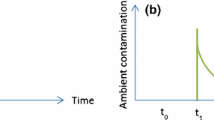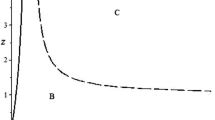Abstract
Most economic studies of pollution externalities focus on the relative efficiency or cost-effectiveness of alternative pollution control instruments. Much less attention has been paid to policy goals and objectives. However, a comprehensive pollution control strategy depends on all of these choices. This paper examines several efficiency properties of cost-effective pollution control strategies in a stochastic setting when economic damages from pollution are unknown. A number of policy goals are considered. In this setting and under a primal approach, it is found that certain stochastic dominance conditions must be satisfied for the strategies to exhibit desirable efficiency properties. A dual approach to cost-effective pollution control, which is based on a stochastic dominance objective, is also considered.
Similar content being viewed by others
REFERENCES
Baumol, W. J. and W. E. Oates (1988), The Theory of Environmental Policy. New York: Cambridge University Press.
Beavis, B. and I. Dobbs (1987), ‘Firm Behaviour under Regulatory Control of Stochastic Environmental Wastes by Probabilistic Constraints’, Journal of Environmental Economics and Management 14, 112–127.
Beavis, B. and M. Walker (1983), ‘Achieving Environmental Standards with Stochastic Discharges’, Journal of Environmental Economics and Management 10, 103–111.
Braden, J. B. and K. Segerson (1993), ‘Information Problems in the Design of Nonpoint Source Pollution Policy’, in C. S. Russell and J. F. Shogren, eds., Theory, Modeling, and Experience in the Management of Nonpoint-Source Pollution. Boston: Kluwer Academic Publishers.
Burrows, P. (1995), ‘Nonconvexities and the Theory of External Costs’, in D. W. Bromley, ed., The Handbook of Environmental Economics. Cambridge, MA: Blackwell Publishers.
Hadar, J. and W. R. Russell (1969), ‘Rules for Ordering Uncertain Prospects’, American Economic Review 59, 25–34.
Hanley, N., J. F. Shogren and B. White (1997), Environmental Economics: In Theory and Practice. New York: Oxford.
Helfand, G. E. and B. W. House (1995), ‘Regulating Nonpoint Source Pollution Under Heterogeneous Conditions’, American Journal of Agricultural Economics 77, 1024–1032.
Hirshleifer, J. and J. G. Riley (1992), The Analytics of Uncertainty and Information. Cambridge, UK: Cambridge University Press.
Levy, H. and Z. Wiener (1998), ‘Stochastic Dominance and Prospect Dominance with Subjective Weighting Functions’, Journal of Risk and Uncertainty 16, 147–163.
Nichols, A. L. (1984), Targeting Economic Incentives for Environmental Protection. Cambridge, MA: MIT Press.
Ohanian, E. V. (1992), ‘New Approaches in Setting Drinking Water Standards’, Journal of Environmental Economics and Management 11, 321–324.
Segerson, K. (1988), ‘Uncertainty and Incentives for Nonpoint Pollution Control’, Journal of Environmental Economics and Management 15, 87–98.
Shortle, J. S. (1990), ‘The Allocative Efficiency Implications of Water Pollution Abatement Control Cost Comparisons’, Water Resources Research 26, 793–797.
Shortle, J. S. (1987), ‘Allocative Implications of Comparisons Between the Marginal Costs of Point and Nonpoint Source Pollution Abatement’, Northeastern Journal of Agricultural and Resource Economics 16, 17–23.
Shortle, J. S. and D. G. Abler (1997), ‘Nonpoint Pollution’, in H. Folmer and T. Tietenberg, eds., International Yearbook of Environmental and Natural Resource Economics. Edward Elgar.
Shortle, J. S., R. D. Horan and D. G. Abler (1998), ‘Research Issues in Nonpoint Pollution Control’, Environmental and Resources Economics 11, 571–585.
Tietenberg, T. (1995), ‘Tradeable Permits for Pollution Control when Emissions Location Matters: What Have We Learned?’, Environmental and Resource Economics 5, 95–113.
U.S. EPA (1995), The State of the Chesapeake Bay.Washington, DC: U.S. Environmental Protection Agency.
U.S. EPA (1994), President Clinton's Clean Water Initiative: Analysis of Benefits and Costs. Washington, DC: U.S. Environmental Protection Agency, Office of Water.
U.S. EPA (1993), Water Quality Standards Handbook, Second Edition. Washington, DC: U.S. Environmental Protection Agency, Office of Water.
U.S. EPA and U.S.D.A. (1998), Clean Water Action Plan: Restoring and Protecting America's Waters. Washington, DC: U.S. Environmental Protection Agency EPA-840-R-98-001.
Author information
Authors and Affiliations
Rights and permissions
About this article
Cite this article
Horan, R.D. Cost-Effective and Stochastic Dominance Approaches to Stochastic Pollution Control. Environmental and Resource Economics 18, 373–389 (2001). https://doi.org/10.1023/A:1011113726358
Issue Date:
DOI: https://doi.org/10.1023/A:1011113726358




